Clergy of the Malankara Orthodox Syrian church follows the West Syriac tradition and therefore have the same vestments of the Syriac Orthodox church. The vestments worn by the clergy vary with their hierarchical order in the priesthood. The deacons, the priests and the bishops have distinct liturgical vestments.
Following are the different orders of Priesthood in Malankara Orthodox Syrian Church:
1. ULMOYO (FAITHFUL)
The 1st order of Priesthood is Ulmoyo. These consists of all Individuals who have gone through the sacrament of HOLY BAPTISM and accepted the True Faith of the Malankara Orthodox Syrian Church and hence has become a part of the Church.
Baptism is the initial and essential mystery and an absolute, decisive action for a Christian. The benefits of Christ's incarnation, death and resurrection are mediated to the believer through Baptism. Baptism engraves upon and imparts to each person afresh the image of God distorted by the effects of sin and hence is the First and Foremost step in the order of Priesthood.
2. MOMYONO (CONFESSOR OF FAITH)
The 2nd order of Priesthood is Momyono, also known as Confessor Of Faith. It consists of those who teaches faith in the church, such as Sunday School teachers etc.
In the first 2 orders, If the person is an Alter Boy, then he wears a kutino, also known as “Srishrusha Kupayam” and can assist a Priest in any of the HOLY SACRAMENTS in the church.
3. MZAMRONO (SINGERS)
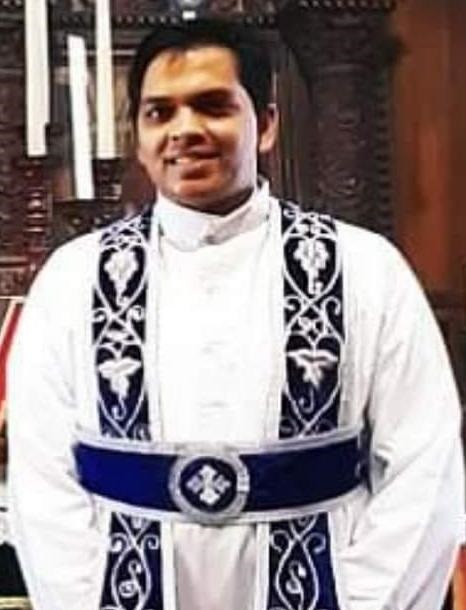
The 3nd order of Priesthood is Mzamrono, also known as Singers.
They are the ones who can officially sing liturgical songs for any of the holy services and guides the choir in the church. They wear the kuttino along with a urara. An urara (‘stole’) is a vestment which distinguishes the different orders of Priesthood. It symbolizes the wings of the Seraphim.
4. KUROYO (READERS)


The 4th order of Priesthood is Kuroyo, also known as Readers.
They are given the duty of officially reciting the Psalms and reading the Holy Scriptures during the Holy Qurbana. They wear a kuttino with a urara, in the form of a cross, along with a black cap, which is worn over the head.
5. YAVPADYAKHNO (SUB DEACONS)


The 5th order of Priesthood is YAVPADYAKHNO, also known as Subdeacons.
Their roles is to oversee and guide those in the lesser ranks (up to Qoruyo), holding the candle during the various parts of the liturgy, and generally making sure that everything in the sanctuary runs smoothly during liturgy. They wear a kuttino with a urara, folded around the neck, along with a black cap worn over the head.
6. MSHAMSHONO (FULL DEACONS)


The 6th order of Priesthood is Mshamshono, also known as Full Deacons.
They are permitted to officially serve in liturgical ceremonies. They assist the priest with the needs of the priest and have the privilege of having the power of the Holy Spirit to read the Holy Evengelion, Promeion and Sedro, give Qurbana to the faithful and lead in the Kuklions. They wear a kuttino with an urara, over the left shoulder, to represent wings and a black cap over the head.
7. KASHISHO (PRIEST)
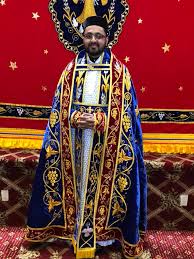
The 7th order of Priesthood is Kashisho. This is when a person becomes a Priest.
The priest's daily dress is a black robe; but in India, due to the hot weather, priests tend to wear a white robe. Along with that, they also wear a small cylindrical black cap which the priest must wear during all public prayers. It consists of seven sections which indicate the full priesthood of the celebrant.

BLACK ROBE WITH BLACK CAP
The liturgical vestments are worn by the priest during the Order of Aaron in the preparatory prayers, also called Thuyobo, that precede the celebration of the divine mysteries. The priest first puts away his outer garments, saying: "Remove from me, O Lord God, the unholy garments wherewith Satan has clothed me by the filth of my evil deeds, and clothe me with the choice garments that are fitting for the service of Thy glory and for the praise of Thy holy Name, O our Lord and our God, forever."
If the priest is a rambaan, he then puts on the eskimo, a hood worn by monks at all times.

ESKIMO
The priest also puts on msone, ceremonial shoes which are worn during the celebration of the Holy Qurbono. Upon wearing the left shoe, the priest recites, "May my feet, O Lord God, be shod with the preparation of the Gospel of peace so that I may tread underfoot serpents and scorpions and all the power of the enemy, for ever". Upon wearing the right shoe, he recites, "Cast down under my foot, Lord God, all false pride that is exalted against Thy knowledge, and grant that by Thy help I may bring the lusts of the flesh into subjection, for ever."

MSONE
He then puts on the kutino 'alb', a white surplice whose color is an indication of the priest's purity. The priest signs the cross over it three times saying, "Clothe me, O Lord, with the robe of incorruption through the strength of Thy Holy Spirit, and make me worthy to keep the true faith and walk in the paths of purity and righteousness all the days of my life."

KUTINO
Then he puts on the hamnikho 'necklace', the stole which symbolizes the priest being armed with the fear of the Lord. He signs the cross over it twice, reciting Psalm 18:39, 40: "Gird me with strength unto the battle and subdue under me them that rise up against me, defeat my enemies and silence those who hate me."

HAMNIKHO
Then he puts on the zenoro 'girdle' which speaks of the priest's control over all bodily desires. He signs the cross over it once reciting Psalm 45:3: "Gird thy sword upon thy thigh, O thou most mighty with thy splendor and glory. Thy glory triumphs."

ZENORO
He then arms himself with the zende 'sleeves' which symbolize the priest's readiness to keep God's Law and do works of righteousness. He signs the cross twice over the left sleeve and recites Psalm 18:34 while wearing it: "He trains my hands to war; and he strengthens my arms like a bow of brass". He then signs the cross once over the right sleeve and recites Psalm 18:35 while wearing it: "Let Thy right hand help me up, and let Thy loving discipline raise me."
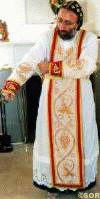
ZENDE
The priest then puts on the phayno, a cope which symbolizes Aaron's robe of many colors and the Savior's seamless robe. He signs the cross over it thrice reciting Psalm 132:9-10: "Let Thy priests be clothed with righteousness and Thy righteous with glory. For Thy servant David's sake, turn not away the face of thine anointed". Then he puts it on reciting Psalm 132:9: "Clothe Thy priests with salvation and Thy saints with glory."
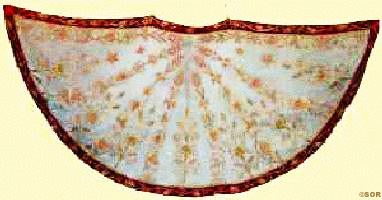
PHYNO
8. BISHOPS
The 8th and the last level of ordination is the Bishops.
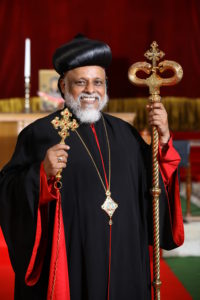
They have all the rights of a Priest along with the right to Ordain Deacons and Priests and Consecrate Churches. Bishops usually wear a black or a red robe with a red belt.
The liturgical vestments worn by a Bishop during the Order of Aaron in the preparatory prayers is similar to that of a Priest along with some additional vestments.
They wear a phiro, a small black cap which the bishop must wear during all public prayers, under the Eskimo, a hood worn by monks at all times. It consists of seven sections which indicate the full priesthood of the celebrant.
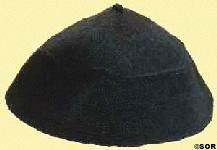
PHIRO
Before putting on phayno, a cope which symbolizes Aaron's robe of many colors and the Savior's seamless robe, Bishops also puts on the masnaphto 'turban', a head-cover which symbolizes the cloth with which the Lord's head was bound for His burial. He makes the sign of the cross twice on it and wears it reciting Psalm 4:6-7: "Who can show me He who is good? May the light of Thy countenance shine upon us, O Lord, Thou hast given gladness to my heart."

MASNAPHTO
Then, he puts on the phayno and then, after that, he puts on batrashil `Pallium' which is similar to the Hamnikho but extends both front and back. It reminds the prelate of the Cross which the Savior carried. He crosses it once reciting Psalm 27:5: "In the day of trouble, he protects me in the shadow of his tabernacle. He exalts me upon a rock; and now he shall lift up my head above mine enemies."

BATRASHIL
Then, Bishops also wear a Cross and an icon, usually of the Mother of God, around the neck. While wearing the cross he recites Psalm 34:5: "Turn your eyes to him and hope in him and you shall not be disappointed."

CROSS AND AN ICON
Then, the bishop takes the crosier (mooroneetho) in his left hand, which symbolizes the bishop's authority and reminds us of the shepherd's staff, reciting Psalm 110:2: "The Lord will send forth the sceptre of Thy power out of Zion: thou shalt rule in the midst of thine enemies". He also takes a hand Cross in his right hand, from which a cloth called mqablonitho 'veil' is hung reciting Psalm 44:5: "For Thy cause we shall combat our enemies and for the cause of Thy name we shall trample those who hate us."
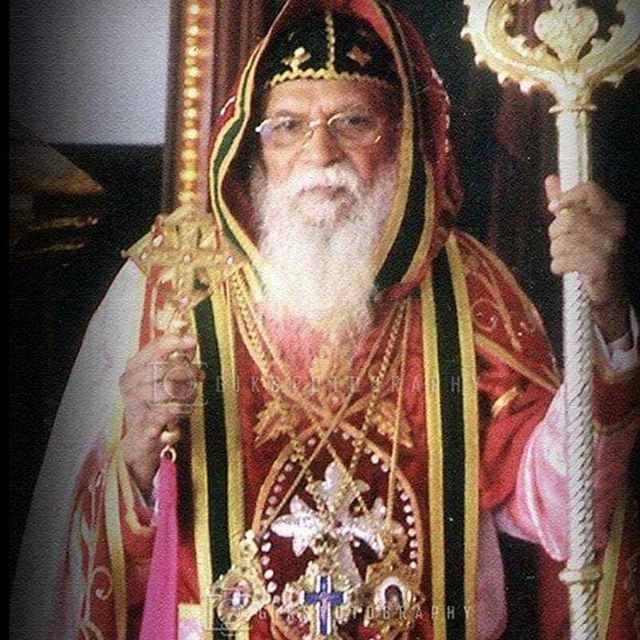
Catholicos Of The East, also known as Malankara Metropolitan
It’s an elevation above the post of a Bishop and his responsibility is to consecrate the mooron and to chair the Holy Synod. He’s the Supreme head of the Malankara Orthodox Syrian Church.
These are the different orders of Priesthood in Malankara Orthodox Syrian Church.



0 comments: